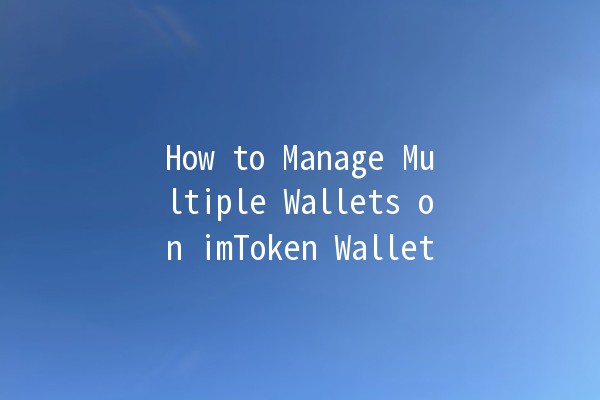In the everevolving world of cryptocurrency, effective wallet management can be a gamechanger. For users of the imToken wallet, juggling multiple wallets might seem daunting, but it can lead to enhanced efficiency and better asset management. This article will explore practical techniques to optimize wallet management on imToken, offering insights and strategies tailored for both novice and seasoned users.
To navigate multiple wallets efficiently, it’s essential to understand wallet hierarchies. imToken allows users to create various wallets for different purposes, such as trading, saving, or even staking. Here’s how you can leverage this feature:

Imagine you have three different wallets: one for Ethereum, one for Bitcoin, and another for altcoins. By allocating specific assets to specific wallets, you can easily track their historical performance and make informed trading decisions without the clutter of mixed assets.
Security is paramount in cryptocurrency management, and imToken offers robust backup options. Here’s how to effectively manage your wallet backups:
A user could set a calendar reminder to back up their imToken wallet every month. They might use a password manager for digital storage and write the recovery phrase on paper, storing it in a safe box at home.
For users who manage substantial amounts of cryptocurrency or operate as part of a team, multisignature wallets offer an additional layer of security and coordination. Here’s how to implement and manage them:
A group of investors can create a multisignature wallet where transactions require signatures from at least three out of five members. This ensures that no one can make unilateral decisions that could jeopardize the group's funds.
The imToken wallet integrates a decentralized application (DApp) browser, which can enhance your wallet management experience. Here’s how to tap into this feature:
By engaging with a lending DApp through imToken, users can lend their assets to earn interest directly from their wallet. This seamless integration allows for easy asset management while maximizing returns.
Sometimes, organizing multiple wallets is not enough; adding contextual information through notes and tags can significantly improve clarity. Here’s how to effectively use this feature:
A trader might tag all trading transactions with a “trade” label and note the rationale behind each trade, such as market analysis or news events. This practice not only organizes transactions but also serves as a learning tool for future trades.
To switch wallets, go to the home screen of your imToken app. You will see a list of your wallets. Tap the wallet you wish to switch to. This simple navigation option makes it easy to manage your assets across different wallets.
Yes, imToken provides a portfolio feature where you can view the overall performance of all your wallets combined. For detailed insights, you may need to check each wallet individually, but this initial overview can help you make quick decisions.
Using multiple wallets can be safe as long as you follow best practices for security, like setting up strong passwords and enabling twofactor authentication. Additionally, ensure you back up each wallet to prevent loss of access.
Yes, inside imToken, you can transfer assets between your wallets with just a few taps. Simply select the asset, choose the wallet to send it from, and select the receiving wallet.
If you lose access, you must use your backup recovery phrase. If you have it stored securely, you can restore your wallet easily. If not, you may permanently lose access to that wallet’s assets.
It’s beneficial to categorize wallets based on purpose and strategy. For daytoday transactions, use your trading wallet. For longterm holding, utilize your savings wallet. Having a clear strategy aligned with your financial goals will guide your choices.
, managing multiple wallets on imToken doesn’t have to be a complex task. By leveraging features such as categorization, secure backups, multisignature options, engaging with DApps, and diligent tagging, users can significantly enhance their management strategy. Remember, the key to successful wallet management lies in organization, security, and continuous learning. As the cryptocurrency landscape evolves, adapting these strategies will help you navigate new challenges efficiently.